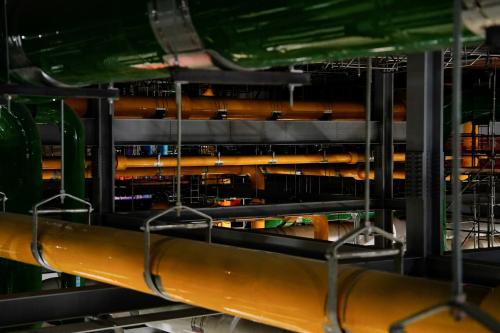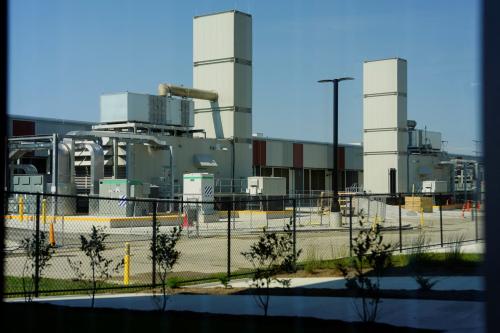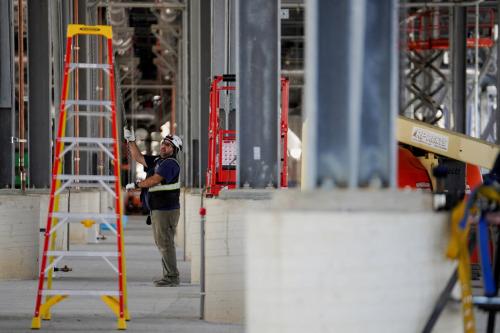The Greater Tulsa, Okla. region boasts long-standing economic strengths, particularly in the energy and aerospace industries. But with lagging growth and prosperity metrics, civic leaders there increasingly realized that generating opportunities for upward mobility—especially amid rapid technological advancement—would require building Tulsa’s foothold in the innovation economy.
This case study examines how the region birthed Tulsa Innovation Labs, a regional economic strategy entity backed by philanthropy, which in turn has mobilized nearly $150 million in federal and corporate investments in its emerging advanced air mobility industry. Key takeaways for regional civic and philanthropic leaders advancing inclusive growth include:
- Philanthropic funders can provide uniquely flexible investments that enable civic leaders to orient regional stakeholders toward transformative bets.
- Philanthropic investment can also help activate corporate capital by de-risking business involvement in regional innovation strategies.
- Catalytic philanthropic investment has provided a strong foundation for regional transformation, but long-term change will require the region to mobilize a more diverse set of corporate, state, and university investment toward regional strategy.
The case study series
Between 2021 and 2022, the federal government passed major legislation authorizing nearly $4 trillion in economic investment, including $80 billion in place-based industrial policy. Brookings has been tracking these investments, including the early implementation of coalition-based grants aimed at advancing key national priorities such as national security and economic and technological competitiveness.
This case study is part of a report series that goes beyond the programmatic efforts catalyzed by these investments to examine the underlying civic infrastructure that regions have begun to build—and will ultimately need to sustain in the long term—to support resilient, inclusive, and innovation-driven economies.
The main report details five functions that regions need, with a particular focus on the unique role of local philanthropy in supporting these functions, both as funders and strategic partners. The five functions are:
- Connect networks and build trust among increasingly disconnected economic actors, including business leaders, community organizations, students, and entrepreneurs.
- Orient regional stakeholders toward a shared understanding of the economy and the pathways to inclusive growth.
- Activate key business leaders to inform, engage, and invest in strategic regional inclusive growth efforts.
- Integrate teams of diverse, complementary organizations to solve specific, high-priority challenges using evidence-based interventions.
- Mobilize resources through sustainable financial models to maintain momentum, using performance measurement tools to identify the highest-priority areas for investment.
The five case studies—Chicago/Illinois; Fresno, Calif.; New Orleans; Syracuse, N.Y.; and Tulsa, Okla.—illustrate how these functions and the philanthropic leadership that enables them play out on the ground. Each region has received different forms of federal funding under the 117th Congress, and also varies in size, geography, and maturity of economic and workforce development ecosystems—thus offering lessons for a range of philanthropic and civic leaders across the country.
Background
Once known as the “Oil Capital of the World,” the Greater Tulsa region has historically been dominated by the energy industry. Today, while energy remains a cornerstone (especially in natural gas and energy infrastructure), the region has expanded into adjacent sectors such as advanced manufacturing, clean energy, and logistics. Tulsa is also home to a strong aerospace footprint, with more than 1,100 companies and the world’s largest commercial aerospace maintenance, repair, and overhaul (MRO) facility.
Despite these assets and industry shifts, in the years leading up to the COVID-19 pandemic, the region’s economy had stagnated. According to Brookings’ Metro Monitor, the Tulsa region’s growth and prosperity trajectories from 2011 to 2021 ranked toward the bottom among metro areas with populations over 1 million—coming in 49th and 54th out of 56 on growth and prosperity indicators, respectively. Yet as in most regions across the country, Tulsa’s economic development entities remained focused on traditional priorities, including business attraction and expansion in broad industry sectors such as manufacturing, professional services, real estate development, and land use.
Fast forward five years, and the Tulsa region has secured nearly $90 million in federal grant funding—activating an additional $100 million-plus in leveraged investment commitments and matches—to build out an advanced aerial mobility (AAM) cluster aimed at advancing drone technologies and meeting national security goals. As detailed in a recent Brookings report, these grants include a $38 million Build Back Better Regional Challenge (BBBRC) award designed “to transform Tulsa into a research, testing, and manufacturing center for [drone-powered transportation technologies]” and a $51 million Regional Technology and Innovation Hubs (Tech Hubs) award for increasing the adoption of AAM technologies and other autonomous systems. The region has also activated $50 million in corporate and philanthropic investment to drive innovation in the energy sector. So, what changed in order to catalyze these potentially transformative investments in Tulsa’s economy?
In early 2020, the George Kaiser Family Foundation (GKFF), decided to create and invest in Tulsa Innovation Labs (TIL), an innovation-driven economic strategy organization dedicated to “secur[ing] Tulsa’s leadership in industries of the future.” GKFF, established in 1999, is a $5 billion donor-advised fund at the Tulsa Community Foundation (TCF), which was founded by George Kaiser in 1998 to act as fiscal sponsor for the region’s community projects. This flexible, catalytic investment by GKFF provided foundational support for TIL’s operational and collaborative capacity, which has since enabled the region to secure significant down-payments toward regional transformation.
How civic and philanthropic leaders are mobilizing federal resources
GKFF was founded with a sharp focus on advancing early childhood education—a cornerstone of its mission to reverse generational cycles of poverty and create opportunities for every child to thrive. Since then, it has maintained that vision but broadened its scope of work to also include place-based investments in prosperity. GKFF operates at the census tract level to enhance housing, education, health, and economic opportunity in historically disinvested neighborhoods of East and North Tulsa, while working at the city and regional level for workforce and other large-scale strategies.
Economic development has grown into one of these large-scale strategic focuses. While GKFF had minimal prior experience in economic development (at least by the traditional definition of growing and attracting businesses), the foundation saw a critical gap hindering its mission of creating long-term opportunities for Tulsa’s children and communities. Not only had the economy itself stagnated, as described above; the region did not have an organization focused on developing an inclusive, innovation-driven economic strategy to drive catalytic change.
Thus, GKFF, as the primary funder of many of the region’s strategic initiatives (from entrepreneurship and talent development to the Gathering Place, the region’s award-winning, free-admission riverfront park), decided to take on the challenge. Drawing on prior experience standing up and funding organizations to execute evidence-based strategies such as reducing incarceration by addressing root causes including trauma and drug addiction, GKFF pioneered TIL to serve as a new technology- and innovation-driven economic development entity for the Tulsa region, with a mandate to create opportunities in industries of the future. As Ken Levit, executive director of GKFF, explained in the months after TIL’s launch: “Economic development is new terrain for GKFF. But we know that to provide long-term opportunities for Tulsa’s families, we need to invest in our local economy and prepare Tulsa for the jobs of the future.”
How civic leaders leveraged catalytic philanthropic investment to drive an innovation-driven cluster strategy
Structurally, TIL exists as a subsidiary of TCF, yet it is exemplary of the frequent collaboration between TCF and GKFF. The two organizations are distinct entities: GKFF often provides catalytic capital for bold bets while TCF provides the broad philanthropic infrastructure to support such initiatives. All in all, TIL’s staffing and operations are primarily philanthropically funded, and the flexible support from GKFF has enabled it to be nimble and opportunistic in creating and seizing emergent opportunities without needing to manage the sometimes competing interests and directives of different funders.
In TIL’s first few years, this philanthropically funded capacity enabled TIL to build an independent, data-driven picture of the innovation economy and, in turn, credibly orient the region’s stakeholders toward high-growth, high-opportunity industry sectors. After extensive industry analyses, it released a report identifying Tulsa’s assets and competitive advantages in four tech-driven industry areas: virtual health, energy, cybersecurity, and advanced air mobility (AAM), where Tulsa could “leverage its existing aerospace sector to jump-start an AAM cluster to further diversify [the region’s] economy.”
Thus, when the Economic Development Administration (EDA) announced the $1 billion BBBRC in 2021, which would make awards of up to $100 million to regions across the country, TIL was ready to align a regional coalition and resources toward the high-potential AAM opportunity.
Yet coalition-building was not a matter of simply presenting the AAM opportunity to regional stakeholders. Some of the region’s economic development and civic leaders had already begun discussing potential proposals for the BBBRC, and TIL was still relatively new in the regional ecosystem. A key source of credibility, in addition to its extensive research, was the backing and influence of GKFF and its mandate to TIL to transform the regional economy. This credibility enabled TIL to enter the regional conversation and quickly partner to shape it, orienting the coalition around a shared vision, narrative, and priorities.
“We had to mobilize fast—connecting with each of our coalition partners to champion advanced mobility as the right vision for the BBBRC,” said Jennifer Hankins, managing director of TIL. “It took relentless coordination, deep collaboration, and a shared commitment to push the effort forward—and that’s what ultimately led to the big win.” The flexible capacity-building resources GKFF provided were critical, enabling TIL’s leaders and staff to spend significant time applying for highly competitive federal challenge grants.
These bets paid off. The Tulsa coalition first won a $38 million BBBRC award, which fueled momentum and provided a foundation for the subsequent $51 million Tech Hubs win, increasing the adoption of AAM technologies in other areas. Since then, TIL has taken on coalition management and governance responsibilities across both awards. It also coordinates the entire Tech Hubs portfolio of projects spanning workforce, innovation, and infrastructure to advance AAM as well as the workforce-related components of the BBBRC coalition’s portfolio.
TIL has had to develop new coordination capabilities to manage these coalitions. For Tech Hubs in particular, TIL has intentionally designed the coalition structure so that federal funding flows through them, then providing sub-awards to project-level implementation leaders—all of which helps hold coalition members accountable to the core strategy. Contracts and sub-award agreements codify TIL’s ability to ensure alignment, track progress, and maximally support project leads in meeting their key performance indicators. All these tasks—not to mention federal reporting and grant compliance—require new capacity, and thus TIL has added three grant-funded positions to support finance, compliance, and administration.
The evolving role of philanthropy for the future of Tulsa’s tech-driven economy
Moving forward, TIL is pursuing a three-part strategy to build on these early successes to secure sustainable corporate, state, and philanthropic investment for the AAM cluster to drive true regional economic transformation. First, TIL is pursuing state investment to complement recent federal investments. Second, it is leveraging philanthropic capital to activate corporate investment, building on the successes of its $50 million Rose Rock initiative—a venture studio that recruits promising energy startups from across the country and connects them with energy companies to accelerate innovation and investment. Rose Rock has leveraged $13 million from GKFF to activate $36 million from area energy companies, leading to the creation of five startups and the adoption of 14 new technologies, driving innovation in the energy sector. Rose Rock has catalyzed follow-on investments and pilot projects with the sourced startups.
Third, TIL will intentionally work to diversify its philanthropic base beyond GKFF. While GKFF’s generous and flexible support has played an irreplaceable role in catalyzing this work, leaders at both GKFF and TIL recognize that the role is not sustainable to achieve the desired scale of long-term regional transformation. Tulsa will need to creatively mobilize and stack diverse sources of capital to support future work. As part of this effort, TIL has been responsive to inquiries from other regional and national funders who have demonstrated interest in mission-aligned objectives, such as partnering with Native American tribes (Tulsa is home to four federally recognized Native American tribes: Cherokee Nation, Muscogee [Creek] Nation, Osage Nation, and Pawnee Nation) and advancing the energy transition. With GKFF’s support amplifying this work, TIL is exploring additional philanthropic sources and hoping to align resources from those sources to sustain the work in the long term.
Key takeaways for civic and philanthropic leaders
Tulsa’s recent track record demonstrates how philanthropic funders can provide uniquely important flexible, independent investments that can orient regional leaders around transformative bets. In particular, flexible investments in staffing and operational capacity allow civic strategists to be nimble and responsive to emerging opportunities, quickly coalescing coalitions around time-limited federal funding opportunities and rapid technological innovation. Philanthropies can also provide the early foundation for big bets and their critical underlying civic infrastructure—unlike states, whose investments may be exposed to shifts in political administrations, and corporations, which tend to be more risk-averse.
For corporate capital in particular, philanthropic investment can play a unique role in activating investment. The value-add of initiatives such as Rose Rock is that they enable corporations to do things together and at scale that they wouldn’t be able to do alone. Similar initiatives across the country include Indianapolis’ AnalytiXIN (a strategic initiative for strengthening data analytics in key industries) and Syracuse, N.Y.’s ON-RAMP (which delivers employer-driven workforce trainings in advanced manufacturing), supported by the Central Indiana Corporate Partnership and CenterState CEO, the regions’ respective civic and business leadership organizations. Like Rose Rock, these initiatives do not develop organically, no matter the degree of business demand—they require funding dedicated staff who deliver on essential collaborative capacity, understand individual and collective business needs, and develop programs and services that are responsive to them.
Ultimately, transforming the regional economy will require more than catalytic philanthropic capital. Prior Brookings research has estimated the cost of surging a region’s tech-based cluster at $10 billion over 10 years, at least in terms of federal government investment. While philanthropic investment has begun unlocking federal and corporate investment (particularly under the 117th Congress, given its focus on place-based industrial strategy), regional leaders will need to learn to mobilize resources in creative ways to continue building a sustainable, long-term resource base for collaborative capacity that stacks and leverages diverse corporate, state, philanthropic, and university resources in alignment with regional strategy.
Case study series


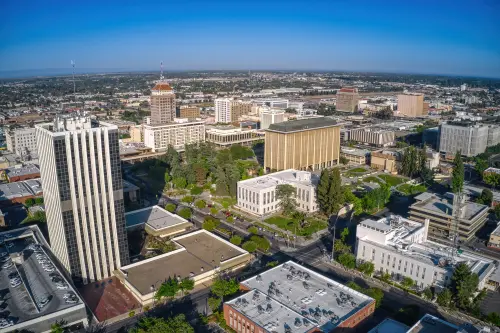
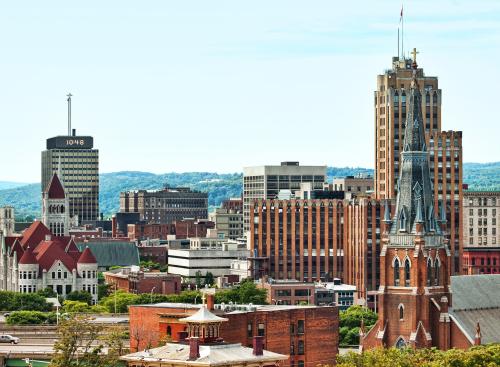

The Brookings Institution is committed to quality, independence, and impact.
We are supported by a diverse array of funders. In line with our values and policies, each Brookings publication represents the sole views of its author(s).



